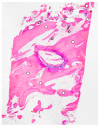Autogenous Dentin Particulate Graft for Alveolar Ridge Augmentation with and without Use of Collagen Membrane: Preliminary Histological Analysis on Humans
- PMID: 35744378
- PMCID: PMC9230765
- DOI: 10.3390/ma15124319
Autogenous Dentin Particulate Graft for Alveolar Ridge Augmentation with and without Use of Collagen Membrane: Preliminary Histological Analysis on Humans
Abstract
(1) Background: The phenomenon of ankylosis of the dental elements has led clinicians to think that properly treated dentin and cement may be a potential graft for alveolar ridge augmentation. Currently, there are no studies in the literature able to histomorphometrically compare the healing patterns of an autogenous dentin particulate graft with the association, or not, of resorbable membranes. The aim of this pilot study is to histologically compare bone after an alveolar ridge augmentation using an autogenous dentin particulate graft with and without a resorbable collagen membrane. (2) Methods: this clinical trial enrolled six patients with defects requiring bone augmentation. Two procedures were performed in all six adult human patients in order to perform a study-control study: in Group 1, a ridge augmentation procedure with an autogenous dentin particulate graft and a resorbable collagen membrane was performed, and, in Group 2, an alveolar ridge preservation without a membrane was performed at the same time (T0). At 4 months, a biopsy of the bone tissues was performed using a 4 mm trephine bur in order to perform a histomorphometric analysis. (3) Results: The histomorphometric analysis demonstrated that Group 1 presented 45% of bone volume, 38% of vital bone, and 7% of residual graft. On the contrary, membrane-free regenerative procedures demonstrated 37% of bone volume, 9% of vital bone, and 27% of non-resorbed graft. In all cases, the regenerated bone allowed the insertion of implants with a standard platform, and no early failures were recorded. (4) Conclusions: Autogenous dentin particulate grafts seem to work best when paired with a membrane.
Keywords: alveolar ridge augmentation; autogenous dentin graft; bone graft histology; membrane; tooth transformer.
Conflict of interest statement
The authors declare no conflict of interest.
Figures





References
-
- Meloni S.M., Jovanovic S.A., Urban I., Canullo L., Pisano M., Tallarico M. Horizontal Ridge Augmentation using GBR with a Native Collagen Membrane and 1:1 Ratio of Particulated Xenograft and Autologous Bone: A 1-Year Prospective Clinical Study. Clin. Implant. Dent. Relat. Res. 2017;19:38–45. doi: 10.1111/cid.12429. - DOI - PubMed
-
- Faria-Almeida R., Astramskaite-Januseviciene I., Puisys A., Correia F. Extraction Socket Preservation with or without Membranes, Soft Tissue Influence on Post Extraction Alveolar Ridge Preservation: A Systematic Review. J. Oral Maxillofac. Res. 2019;10:e5. doi: 10.5037/jomr.2019.10305. - DOI - PMC - PubMed
LinkOut - more resources
Full Text Sources

